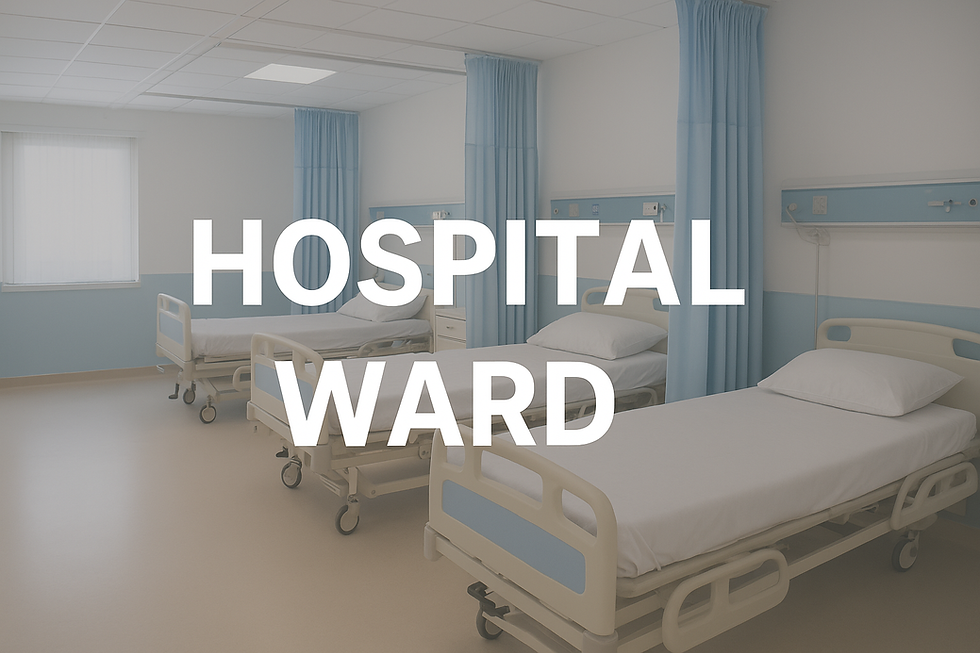Customizable OT Trolleys: Solving space constraints in Compact Operating Rooms
- Dhruv Dixit
- May 22
- 4 min read
In surgical care, efficiency and safety are of utmost importance. Operating rooms (ORs) must operate as high-functioning ecosystems, spaces where every square inch is optimised for critical procedures, sterile protocols, and seamless teamwork. However, with increasing urbanization, rising patient volumes, and a surge in demand for multispecialty surgical services, many hospitals, especially those in metropolitan regions are faced with a growing dilemma: space.
Compact operating rooms, common in older healthcare facilities or smaller urban clinics, are often not equipped to accommodate the sophisticated range of modern surgical equipment. From C-arm imaging systems to anesthesia workstations and vital monitoring apparatus, the footprint of essential tools has expanded, while the physical dimensions of ORs have largely remained static.
Within these limitations, even minor inefficiencies in design can have cascading effects on procedural performance, safety, and outcomes. It is in this constrained and high-pressure environment that customizable OT trolleys are emerging as a transformative solution.
These are no longer just basic utility carts with wheels, they are purpose-built, procedure-aligned instruments that effortlessly blend functionality with spatial intelligence.

A Practical Response to Spatial Constraints
The reality of spatial limitations in operating rooms cannot be neglected. Hospitals built several decades ago were never envisioned to host the complex, tech-integrated procedures we see today. Surgeons and operating staff frequently face logistical hurdles, navigating around fixed equipment, handling overlapping utilities, or compensating for a lack of dedicated zones for surgical tools. The result is often workflow disruption, heightened risks of contamination, and unnecessary delays during procedures.
Standardized trolleys, mass-manufactured to generic specifications, have little role in addressing such nuanced challenges. A uniform model does not account for architectural limitations or surgical specialties.
This is where customized OT trolleys become invaluable. By adapting to the room, rather than forcing the room to adapt to them, they provide a fluid, user-centric solution that aligns with both spatial and procedural needs.
Design That Responds to Clinical Realities
Custom OT trolleys are engineered not just for movement, but for maneuverability under constrained conditions. These solutions incorporate design elements such as low-profile builds, pivot-friendly wheel systems, and adjustable height settings, ensuring hassle-free mobility even in tight layouts. Unlike their off-the-shelf counterparts, they are tailored to support dynamic intraoperative repositioning without compromising the sterile field or obstructing the surgical team.
Moreover, the build materials used—typically high-grade, anti-corrosive stainless steel—contribute to durability and ease of sterilization. Rounded corners and seamless welds reduce bacterial accumulation points, making them ideal for fast-paced turnover between procedures. The result is a mobile storage system that facilitates operational efficiency while adhering to stringent infection control protocols.
Procedure-Centric Configurations
The most significant advantage of customization lies in the ability to align trolleys with the specific procedural workflows of the operating team. Each surgical specialty, from ophthalmology and neurosurgery to orthopedics and laparoscopic interventions, demands a distinct set of instruments, devices, and consumables. Customizable trolleys can be configured accordingly.
This level of procedural alignment ensures that tools are not only stored but are intuitively accessible in the exact order and position that mirrors the surgical protocol. The reduction in search time and manual handling significantly mitigates intraoperative risks and enhances surgical precision.
Ergonomic and Staff-Friendly Layouts
Custom OT trolleys resolve these issues through human-centered design. Features such as swing-arm attachments, collapsible extensions, and under-unit storage compartments allow teams to access instruments with minimal movement and without disrupting the procedural flow. Handles are placed strategically to reduce strain, and the overall layout is configured to allow unimpeded circulation within the OR. When every member of the team can operate efficiently without physical hindrance, the outcome is a calmer, more focused surgical environment.
Simplified Sanitation and Infection Control
In any operating theatre, hygiene is non-negotiable. But in smaller ORs, maintaining sterile conditions is doubly challenging. Custom-built trolleys are designed to address this head-on. Their streamlined geometry, minimalistic frames, and modular structures allow for thorough cleaning in shorter durations. Advanced models often incorporate removable trays, anti-microbial coating options, and seamless joints that eliminate dust and biological trap zones. Some variants are even compatible with UV-C disinfection protocols or automated sanitization workflows.
Regulatory Compliance Made Simpler
Hospital equipment must adhere to a complex web of compliance mandates, ranging from biomedical safety to ergonomic guidelines. Custom trolleys, when designed in consultation with regulatory frameworks, simplify this process. They can be fabricated to meet electrical safety standards, load-bearing specifications, or sterilization compatibility as per ISO, NABH, or local guidelines.
There’s a tendency in healthcare procurement to opt for standard, cost-effective solutions. Reduced procedural delays, minimized contamination risks, fewer replacement costs, and increased staff efficiency all contribute to a significantly improved return on investment.
In fact, over the course of a year, the savings generated through improved workflow and minimized disruptions can easily offset the cost differential, making customized OT trolleys not just a good choice, but a smart one.
Why Choose Aslam Enterprises for Customized OT Trolleys
At Aslam Enterprises, we understand that no two hospitals, or even operating rooms are the same. Our approach to build customizable OT trolleys is rooted in a deep understanding of hospital infrastructure, surgical workflows, and compliance protocols specific to the Indian healthcare ecosystem.
Each trolley is built in consultation with medical professionals, ensuring ergonomic optimization, intuitive layouts, and seamless compatibility with existing OR designs. From narrow-profile builds to multi-layered modular units, we offer flexibility without compromising on quality. Our products are crafted from high-grade stainless steel, with precision engineering that supports both high hygiene standards and operational resilience.





Comments